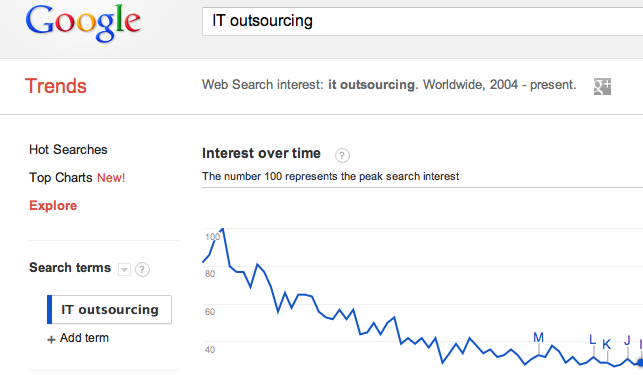 As we make our way through 2013, it’s interesting to see how predicted trends in IT outsourcing are panning out. Last December, as the new year was about to get underway, respected online industry resource CIO.com published their predictions, based on extensive executive interviews.
As we make our way through 2013, it’s interesting to see how predicted trends in IT outsourcing are panning out. Last December, as the new year was about to get underway, respected online industry resource CIO.com published their predictions, based on extensive executive interviews.
Let’s look at five of those trends.
1. Taking the reins back -- governance takes precedence.
IT outsourcing clients – executives like you – want more control. Well-defined SLAs are fine, but buyers want to know that they’re getting what they’re paying for. They want a greater say in how work is handled day in and day out.
They expect more transparent management of incidents and problems and changes. “Single source of truth” is becoming the new mantra for companies and their providers looking to track results uniformly and openly.
2. Homecoming – proximity has its benefits.
Offshoring, the process of handing over IT outsourcing functions to providers in a foreign country, is losing ground in favor of local or at least regionalized partnerships.
Executives say working with providers closer to their own backyard – within the same state or at least within a given continent -- facilitates greater communication, quality and control, without necessarily costing more. In particular, they cite benefits derived from working with providers familiar with local cultural and language nuances.
Some companies, frustrated with their outsourcing experience, may decide to recapture certain functions to achieve 100% internal control. For those considering outsourcing for the first time, this underscores the value of taking “baby steps” to become more assured with the process before undergoing a radical transformation.
3. More pricing options.
CIO.com predicted a movement away from fixed-based pricing, toward transaction- or outcome-based pricing, as a means of facilitating process automation. Establishing special-purpose funding pools may allow some companies and their providers pay for development of new innovations in automation or cloud technologies.
And economic considerations -- or simply internal corporate cash flow needs or preferences – are driving more companies to seek more flexible contract options, with payment terms as far out as 90 days.
4. Hybrid environment.
IT outsourcing is just one area in which companies are looking to hybrid solutions that best meet their unique needs and circumstances. In-sourcing, outsourcing and as-a-service options are all on the rise. That’s good news if you’re searching for alternatives.
5. Haste makes waste. And causes disputes.
One thing is certain. Companies that choose IT outsourcing but fail to base their decision on fully understand their own business case, or who rush to finalize the process without first defining clear and detailed plans for transition and transformation, are in for a rocky experience. They’ll see delays and perhaps even failed implementation, resulting in increased disputes with suppliers.
And as initial IT outsourcing contracts come due for renewal, corporate execs and IT managers will face more questions about whether to stick with the provider they know or consider making a switch. It’s a process eerily similar to the original should-we-or-shouldn’t-we outsourcing decision, though with an added advantage of first-hand lessons learned. Will another transition be easier? Or just as difficult as the first time around?
Although CIO.com notes some companies may try to take on IT outsourcing without help from an IT management and sourcing consultant, the breadth and depth of emerging changes in the outsourcing marketplace suggest this may be a poorly-considered approach.
IT outsourcing can produce significantly improved results. It’s proving its value, but it’s still in a state of flux.
Photo credit: Google Trends

